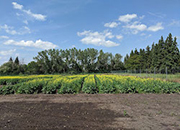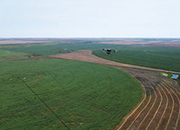| |
| |
 |
 |
| |
 |
|
@{mv_date_MMM d, yyyy}@ |
|
| |
 Flaxseed prices are down distinctly from last year, but soybean prices are up 35 per cent.
» Read more...
Flaxseed prices are down distinctly from last year, but soybean prices are up 35 per cent.
» Read more...
All four new members have experience farming, with many holding leadership or director positions in the industry.
» Read more...
It’s vital to address and correct misinformation about genetic modification in crops.
» Read more...
|
| |
 |
 |
| |
|
| |

Fairness means different things to different farm team members and the non-business heirs. Join Elaine Froese, farm family transition coach, at 10 a.m. CT/11 a.m. ET on Dec. 1 for a discussion on the following session solutions:
- Learn to ask powerful questions to uncover what fairness means
- Glean Better conflict-resolution language
- Activate the FAIR approach of financial transparency
- Know the questions to ask and how to get better understanding of what fairness looks like to you and each family member
|
| |
|
| |
 Clubroot can cause a world of damage – one estimate reported that clubroot cost the country’s canola industry $500 million in profits over the last decade. And, with new strains overcoming clubroot resistance, any control strategies that show the slightest hint of promise deserve meaningful investigation. Recently, field trials began to test applying lime to increase soil pH, thus limiting clubroot severity.
» Learn more...
Clubroot can cause a world of damage – one estimate reported that clubroot cost the country’s canola industry $500 million in profits over the last decade. And, with new strains overcoming clubroot resistance, any control strategies that show the slightest hint of promise deserve meaningful investigation. Recently, field trials began to test applying lime to increase soil pH, thus limiting clubroot severity.
» Learn more... |
| |
 The ag industry continues to adopt the use of unmanned aerial vehicles (UAVs), known colloquially as drones, for field scouting and monitoring. Now, researchers and industry are interested in evaluating emerging sensor technologies that can enhance crop health observations and better inform precision management decisions. A new three-year project based in Saskatchewan will use UAVs equipped with LiDAR to remotely sense multiple indicators of crop biophysical status for common crops. The goal is develop specific recommendations for farmers, agronomists and crop specialists to use on their own UAVs.
» Learn more...
The ag industry continues to adopt the use of unmanned aerial vehicles (UAVs), known colloquially as drones, for field scouting and monitoring. Now, researchers and industry are interested in evaluating emerging sensor technologies that can enhance crop health observations and better inform precision management decisions. A new three-year project based in Saskatchewan will use UAVs equipped with LiDAR to remotely sense multiple indicators of crop biophysical status for common crops. The goal is develop specific recommendations for farmers, agronomists and crop specialists to use on their own UAVs.
» Learn more... |
| |
|
| |
 Palmer amaranth is a term that makes farmers and agronomists shudder a little each time it’s mentioned. Native to the United States, it’s an invasive weed that has been on the radar in Canada for several years due to its ability to develop herbicide resistance so quickly. As Kim Brown-Livingston states, it grows quickly and causes incredible economic damage, making it a super (concerning) weed.
» Listen now...
Palmer amaranth is a term that makes farmers and agronomists shudder a little each time it’s mentioned. Native to the United States, it’s an invasive weed that has been on the radar in Canada for several years due to its ability to develop herbicide resistance so quickly. As Kim Brown-Livingston states, it grows quickly and causes incredible economic damage, making it a super (concerning) weed.
» Listen now... |
| |
|
| |
|
|
| |
| |









